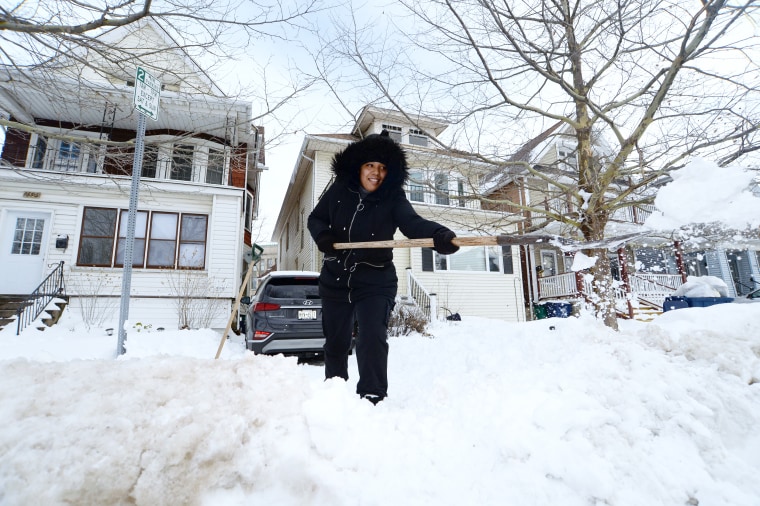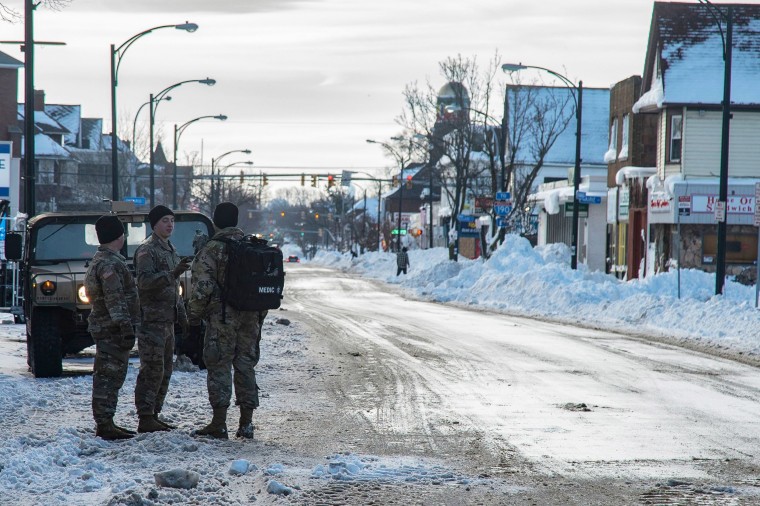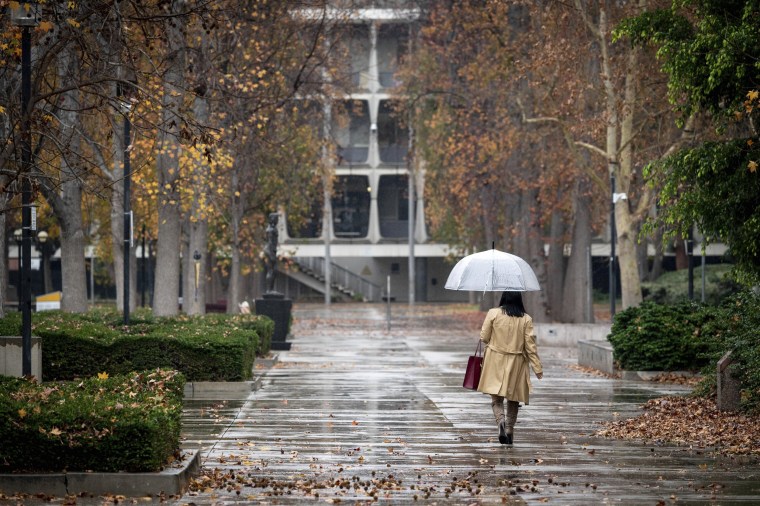New York is preparing for possible flooding due to warm temperatures expected to melt several feet of snow that piled up from a deadly winter storm, while the West is expecting heavy rain and snow to continue falling through the end of the week, according to the National Weather Service.
Highs in the mid-40s are expected in New York City and Buffalo on Thursday, where temperatures will likely climb into the low-50s the next two days. Earlier this week, the Buffalo area saw temperatures as low as 4 degrees, according to the agency.
New York won’t be alone: Temperatures across much of the country “will undergo a drastic warm up in comparison to those near the start of the week,” the weather service said in a bulletin Thursday morning, with Eastern states seeing highs into the 50s and the 60s. The forecast comes a day after the nonprofit organization Berkeley Earth said 2022 is likely to be the fifth-warmest year on record.
Dallas could see a high of 71 degrees Thursday, while Chicago and Washington, D.C., could see a high of 57 degrees. Dallas will see highs in the 60s and low-70s this holiday weekend, while the nation’s capital will see highs in the high-50s and the low-60s. Highs in Chicago will be comparatively more moderate, in the low-50s between Friday and Sunday.

Snow to melt in Buffalo as travel resumes
The warmup will help melt snow in areas across western New York that remain buried under several feet.
Across western New York, snowmelt alone does not normally cause major or widespread flooding and usually needs to occur simultaneously with a heavy rain event, which is not in the forecast for that region — though some localized flooding may occur in the coming days.
The New York State Division of Homeland Security and Emergency Services warned in a tweet that “the mix of higher temps, rain & snowmelt may cause basement flooding, ponding of water in low-lying areas & ice jams” and urged people to contact their local fire department or emergency management office if they have concerns about flooding.
Gov. Kathy Hochul on Wednesday directed state agencies to prepare to respond to flooding caused by the snowmelt. The state has more than 300 pumps, more than 300 generators and more than 775,000 sandbags available to deploy in the event of flooding, according to a news release from her office.

The anticipated snowmelt comes as Buffalo — the epicenter of the storm in Erie County, where 37 people died, 29 of whom were in Buffalo — lifted its travel ban at 12:01 a.m. Thursday, following an announcement from Mayor Byron Brown late Wednesday. A travel advisory remains in place for the area, with Brown asking people to avoid driving unless necessary. Erie County remains under a state of emergency, officials said.
“Some people have not been able to restock groceries, to restock medications, to get to medical appointments, and being able to lift the travel ban safely now will allow people to do those important things,” he said.
All major state highways in western New York, including the Erie County portion of Interstate 190 and several state routes, also reopened at midnight, Hochul announced. And the Buffalo Airport — where nearly 52 inches of snow fell during the storm, according to the weather service — reopened Wednesday.
In a tweet early Thursday, Erie County Executive Mark Poloncarz urged locals to exercise caution when walking or driving given that “hundreds of very large pieces of equipment will still be out clearing streets from curb-to-curb.”
He said in a tweet Wednesday night that 500 National Guard members have conducted nearly 850 welfare checks on residents who had long-term power outages.
Search and rescue teams were returning Thursday to check locations where bodies had been reported but could not be confirmed — either because of the amount of snow or the vagueness of location, according to Buffalo Police Commissioner Joseph Gramaglia.
At least 76 people died in the storm overall, according to an NBC News tally, with weather-related deaths also reported in Colorado, Kansas, Kentucky, Ohio, Nebraska, Missouri, Oklahoma, Michigan, South Carolina, Tennessee, Wisconsin, Illinois and Vermont.
Stormy weather conditions from separate storm systems also proved fatal earlier this week in Oregon. Trees falling on cars led to the deaths of five people — including a 4-year-old girl — in three separate incidents on Interstate 84 and Highway 26 on Tuesday, according to Oregon State Police.
Rain and snow likely in the South and the West
The South and the Gulf Coast could see strong thunderstorms Thursday, including the cities of Houston, Shreveport, Louisiana, and Little Rock, Arkansas. The main risk will be damaging winds followed by hail and a low chance of a tornado.
Meanwhile, a series of storms will hit the West — and California in particular — Thursday into the weekend. The West Coast and parts of the Deep South will receive “moderate to heavy precipitation” following a series of storm fronts that will move in through the West and exit across the Plains, according to the weather service.

As many as 15 million people are under flood watches in Northern and central California, where rainfall is expected to surpass 5 inches in some areas.
Northern and central California and parts of southwest Oregon are slated to receive heavy rain and snow, with 3 to 6 inches of rainfall forecast in the latter region through early this weekend, possibly leading to “scattered instances of flash flooding,” the weather service said. Snowfall in the higher elevations of the Sierra Nevada, above 9,000 feet, could see up to 5 feet of snow.
Moderate to heavy snow could also fall across northern Nevada by Friday night, the agency said.
On New Year’s Eve, heavy rain will fall in the Southeast up to the Ohio Valley during the day and the mid-Atlantic into the Northeast during the evening, while the West will face a flood risk and continued heavy mountain snow.
On New Year’s Day, lingering rain showers are expected in New England, above-average temperatures are set for the South and rain and snow are expected in the Southwest.
Source: | This article originally belongs to Nbcnews.com










